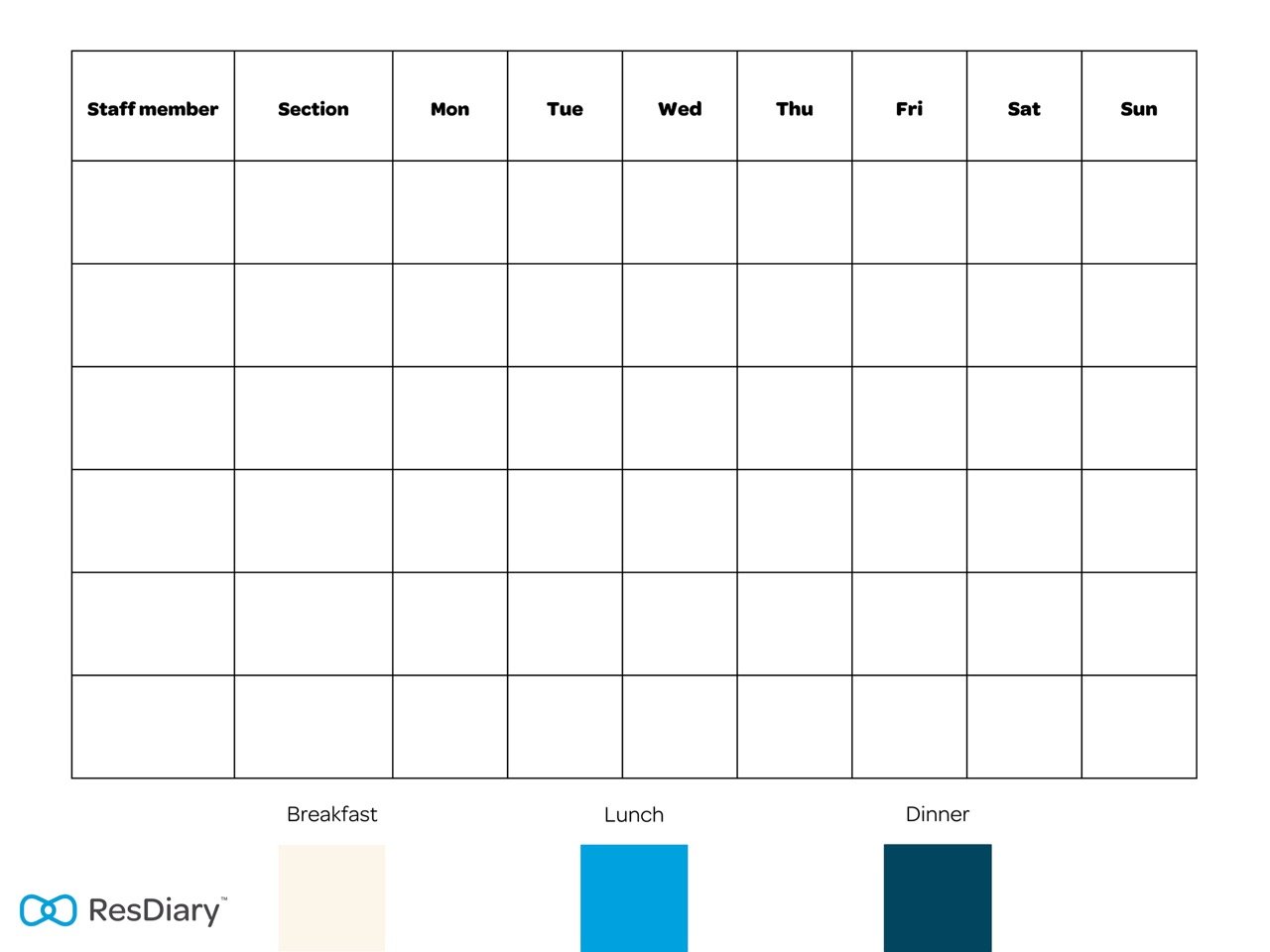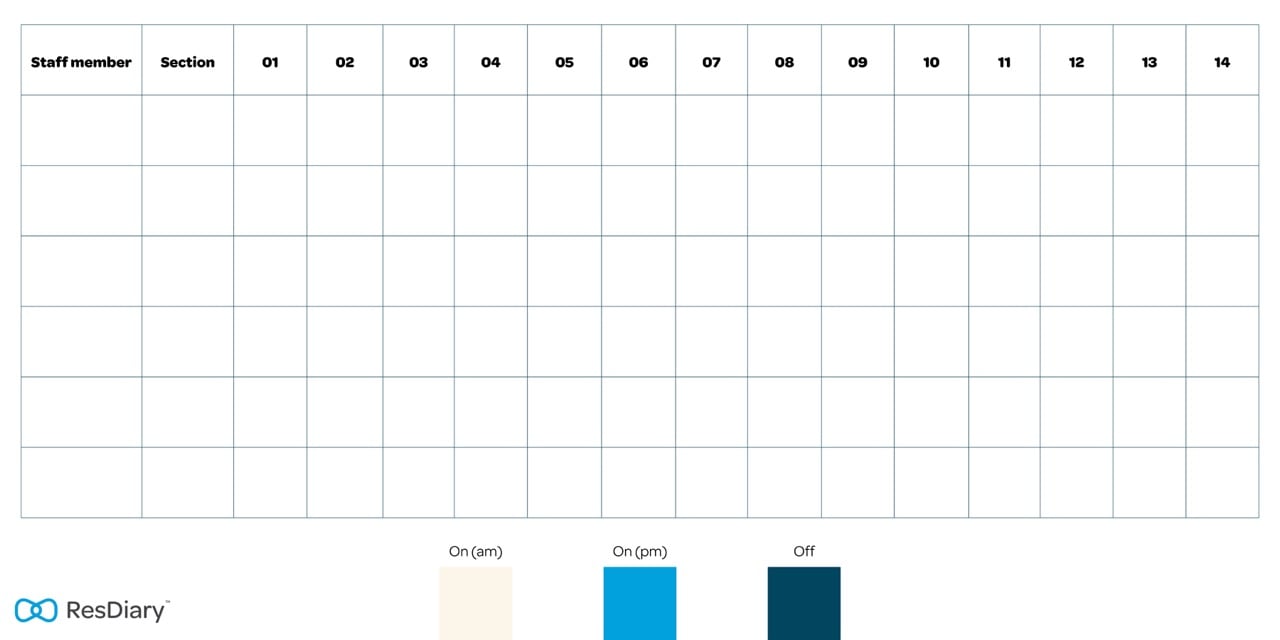Optimising rosters in your restaurant is essential for long-term success. Balancing the needs of your business, staff and customers can be a difficult task.
Creating a fixed roster that is followed week in and week out is often the go-to strategy for hospitality venues. However, a rolling roster featuring rotating shifts that change from week to week can often be more productive. This is especially true if your business employs part-time and casual workers.
In this guide, we will comprehensively analyse the pros and cons of rotating rosters. We will also provide examples and templates of rotating rosters you can use to implement in your business.
What is a Rotating Roster?
A rotating roster is a work schedule in which employees' shifts and work patterns are flexible, and can change frequently. Rotating rosters are also referred to as rolling rosters.
The term "rotating roster" can be used to describe any rostering system that is not identical on a week-to-week basis. A workplace that utilises a particular roster for a month before changing it heading into the next month is using a rotating roster system. A workplace that creates a new roster from scratch every week is also using a rotating roster – albeit an extremely inefficient one. There are of course hospitality rostering solutions available that can benefit from being used alongside restaurant scheduling software, like your booking system.
Benefits of Using a Rotating Roster
A rotating roster takes much more work to create than a fixed roster. So why do managers go to all this effort? Because rotating schedules offer many benefits when compared to other rostering systems.
Flexible Shift Patterns
The greatest asset offered by a rotating shift schedule is flexibility. While a fixed roster offers a regimented working pattern that can be annoying to break, rotating shift schedules are far more agile and adaptable.
Consider this example. Your employee has informed you that they will not be available to work their night shift next Wednesday, as they are taking a trip with their family. If your business is using a fixed roster, you will need to begin the process of asking your employees who are available to fill that shift. As your workers are used to operating on a fixed schedule, many of them have made plans for that Wednesday and will be unavailable to fill the shift.
If your business is using a rotating roster, this problem becomes much easier to solve. All you need to do is check your workers' availability and assign the shift to someone who is able to work it. Since your employees are accustomed to a more flexible system of working, they will be much more amenable to taking on the shift.
Casual and part-time workers are common in hospitality, and accommodating these schedules often necessitates a flexible, rotating roster. Flexible shift patterns have other positive effects too. It becomes much easier to change your operating hours on public holidays when you can create a fresh schedule from scratch.
Flexible Working Conditions
Fixed rosters can ultimately be very unfair to your employees. Hospitality is a business of peaks and troughs on a daily basis. If the same workers are required to work during peak hours every week, they will become tired and discontented.
They will begin to wonder why they are forced to work all the shifts during the business' busiest times while their colleagues are allowed to work during more relaxed times. Similar complaints can arise regarding night shifts.
On the other hand, workers who frequently work 0ff-peak may become upset that they will receive far fewer tips than their colleagues.
If your business uses a rotating roster, it is much easier to ensure busy periods and quiet periods are more evenly distributed among employees. You can also ensure particular employees aren't asked to work every single weekend.
A fairer working environment is a happier working environment. Your employees will come to work with greater enthusiasm and will perform better. Your business will also be known as a great place to work, bolstering employee attraction and retention.
Varied Working Conditions
Rolling shifts allow your workers to explore different aspects of your business. They can work at different times and with different colleagues.
The benefits of varied working conditions are manyfold. Employees who go from working the breakfast shift to the lunch shift to the dinner shift will find their days more interesting and less mundane. They will get to meet different colleagues and regular customers, and will develop new skills and abilities.
No roster is truly fixed. There will always be last-minute alterations to any work schedule, so having versatile, well-trained employees is a great way to ensure your business is ready for anything.
Disadvantages of Using a Rotating Roster
A rotating roster is not perfect. This scheduling system comes with drawbacks that will be felt throughout your business.
Inconsistency
By far the biggest flaw in a rotating roster is inconsistency. While employees do benefit from rotating rosters in some ways, they will often desire the stability and assuredness that comes with a fixed roster.
Having the same employees working the same shifts each week can often be ideal. They will come to know how to work well together and will be well-equipped to deal with the particularities of a given shift.
For example, if you have a set crew of dinner-time workers at your licensed venue, it's easy to assemble a squad of accredited staff who know how to deal with patrons who have been drinking.
Harder to Organise
Constantly creating fresh rosters can take up a lot of time. This is an opportunity cost – it takes away from your ability to work on other tasks.
However, it is worth noting that when you use a fixed roster, you can't simply create one document and never alter it. There will always be amendments that need to be made, and having a flexible roster system in place makes it easier to implement these changes.
Employee Morale
While every employee is different, there's no doubt many of your staff will enjoy the stability that comes with working set shifts on a weekly basis. Fixed rosters make it much easier for employees to plan out their lives.
In addition, a set schedule allows workers to bond more deeply with the same colleagues week in and week out. This can lead to happier staff who are more excited to come to work each day.
Rotating Roster Examples & Templates
When it comes to creating a rotating roster, you don't need to reinvent the wheel. There are plenty of rotating roster formats and concepts you can steal to help your business run more efficiently.
Many restaurants choose to divide their workdays into 3 shift segments, neatly aligning with the meals of breakfast, lunch and dinner. Another way to divide the say is with a day shift, swing shift and night shift. This allows you to easily align your employee's schedules. This method also allows your workers to enjoy some of the stability that comes with a fixed roster. Follow the template below to create this popular style of rotating roster.

An alternative style of this rotating roster involves splitting up your staff into teams and assigning each team to a particular service time.
It's also popular to create rotating rosters in which employees work a certain number of days, before having a certain number of days off. This style of rotating schedule is often created on a month-to-month rather than a week-to-week basis. Many employees will enjoy having a set number of days on and a set number of days off, allowing them to plan special events and trips.
Common examples of this style of roster include four days on, four days off, and five days on, two days off. To reduce confusion, it can help to create this style of roster with a smaller number of shifts each day, such as two eight hour shifts. You can create this style of roster with the template below.

Using a Rotating Roster in Your Restaurant
Rotating rosters are very popular choices among hospitality venues. The nature of restaurant service and casual and part-time employees makes it an ideal choice.
Here are some tips to maximise the effectiveness of rotating rosters in your restaurant:
- Create employee availability forms for your staff to fill out. These will provide a resource you can quickly check in on to fill shifts.
- Take it a step further and converse with your employees about their preferences. You can't make everyone happy, but it pays to know which staff would prefer to have weekends off and who likes having time off during the week.
- Consider roster scheduling software to speed up the process. This software allows you to automate processes that could otherwise take hours. For example, roster creation software allows you to input employee availability, and will automatically disallow you from creating rosters that conflict with the ability of staff to work shifts.
- Set aside the necessary time. It might be a drag, but don't rush the roster creation process. Keep in mind factors like overtime pay, peak periods, and regulatory factors around shift length and mandatory time off.
Using ResDiary to Optimise Your Rosters
ResDiary is the perfect platform to help you create the rosters you need to help your business succeed. As a leading table management system, ResDiary allows you to use future Booking Reports so you know exactly how many staff you need on a given day based on reservation data.
ResDiary also offers a range of integrations to provide even more data, such as EPOS integrations and customer records. More intelligent rostering leads to a superior dining experience for your customers, which should be the goal for any business.
To find out more about how ResDiary can help your business in the areas of rostering and beyond, book a free, personalised demo today.



.jpg)
-2.png)
